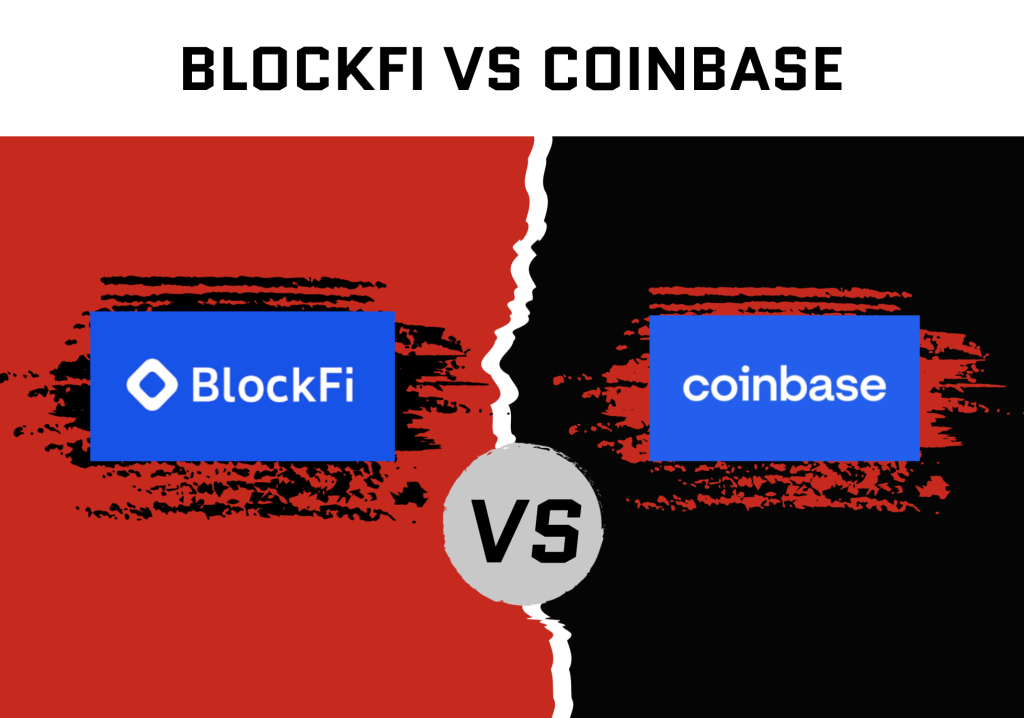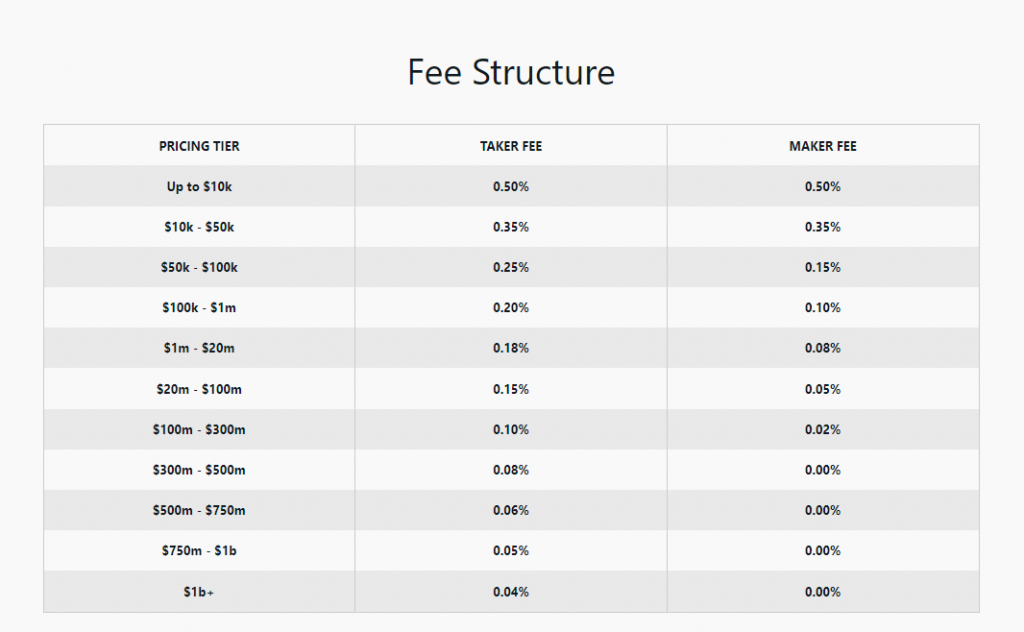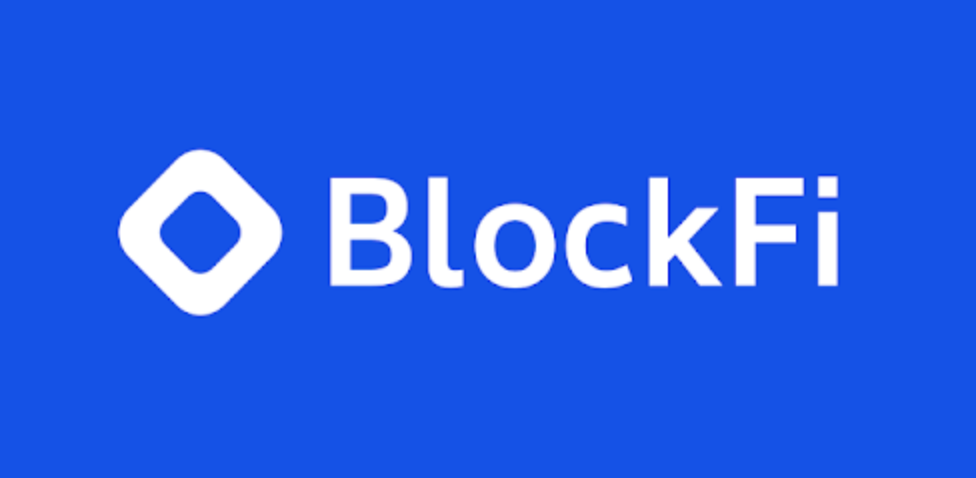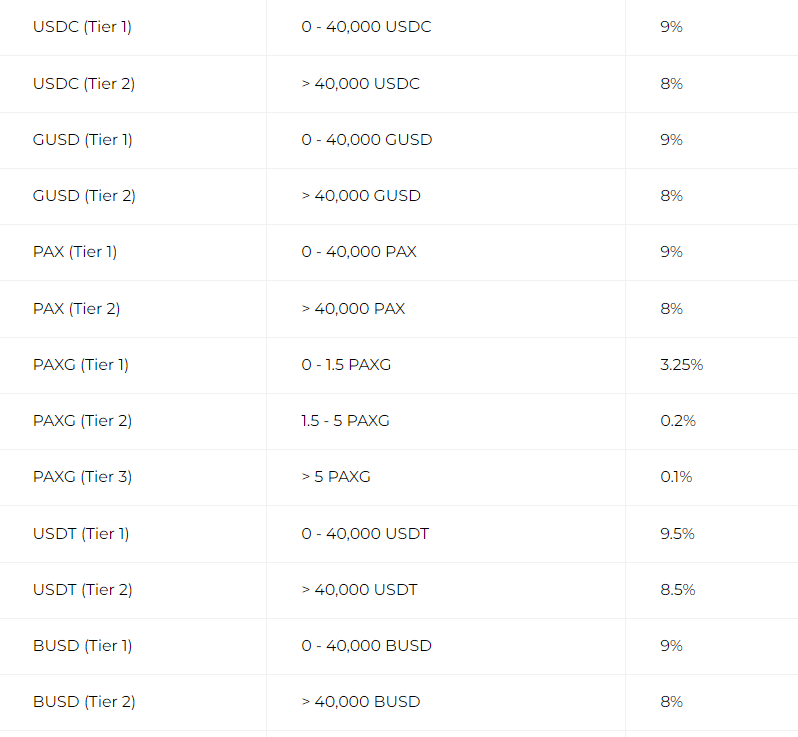BlockFi vs Coinbase, we shall be looking into both of these crypto exchange platforms in detail and figure out which is a better option for you.
Brief Introduction
BlockFi and Coinbase both are American companies. BlockFi is a start-up crypto exchange platform that was founded in 2017 with its headquarters in New Jersey.
Coinbase, however, operates as a remote-based company that was founded back in 2012.

BlockFi and Coinbase both allow crypto trading to their users that includes buying, selling, exchanging, withdrawing, sending, and receiving the crypto assets. In addition, BlockFi also offers interest-earning accounts and low-cost USD loans with crypto assets as collateral.
In this comparison post, we will be looking into factors that differentiate BlockFi and Coinbase from each other by going over topics like products and services offered, cryptocurrencies selection availability, accessibility, fee structure, security, and customer support services.
BlockFi vs Coinbase: A Comparison Summary
- BlockFi offers 14 types of crypto-related assets whereas Coinbase offers more than 80.
- Both the platforms offer two factor authentication, allow-listing, use cold storage and follow AES-256 encryption. BlockFi assets stored on hot storage are insured by Gemini, whereas, Coinbase has FDIC insurance on fiat balances, platform insurance against theft and offers multi-signature wallets.
- BlockFi allows wire, ACH transfers and crypto deposits whereas Coinbase lets customers use credit/debit cards, bank transfers, ACH transfers and crypto deposits.
- BlockFi provides fee-free trading of crypto assets but has charges on crypto-backed loans whereas Coinbase charges a spread fee of 0.50% along with additional varying convenience fees. Both platforms charge a withdrawal fee (Depends on the transactions type & currency).
- BlockFi and Coinbase both have mobile applications for both Android and iOS users.
- BlockFi offers BIA which lets users earn interest off their crypto assets whereas Coinbase does not.
- Customer care services provided by BlockFi are better in comparison to Coinbase whose representatives are sometimes unreachable.
How Do They Make Money?
Coinbase makes money mainly through the fee it charges for trading cryptocurrencies, credit card transaction fees, custody service, and profits from venture investments. BlockFi however claims itself as a fee-free trading platform.
BlockFi’s business model is centered around the spread they earn by borrowing the capital at certain rates and lending them to counterparties at higher charges. These borrowers include:
- Over the counter (OTC) market makers connect buyers who do not wish to transact digital assets over public exchanges to the sellers.
- Businesses like crypto ATMs for providing liquidity of funds to their user base since most of their assets are stored in cold storage.
- Traders and investment funds who see fragmented marketplace and try taking the advantage of crypto assets mispricing between markets or exchanges. They buy and sell these assets simultaneously in order to make greater profits.
It also makes money through the fees charged on loan interests, withdrawals, sponsorships, and crypto mining.
Crypto-Assets Selection Availability
BlockFi supports a limited number of crypto assets that currently include nine cryptocurrencies along with 5 US dollar-based Stablecoins. Available digital currencies are Bitcoin, Ethereum, Litecoin, DAI, LINK, Paxos Standard, PAX Gold, Uniswap, and Basic Attention Token (BAT) whereas Stablecoins offered are USD coin (USDC), Binance USD (BUSD), Tether (USDT), Gemini dollar (GUSD) and Pax dollar (USDP).
In this category, Coinbase definitely earns the point against BlockFi, as it currently offers 85 types of digital assets including both cryptocurrencies and Stablecoins.
Risk & Security Measures
Starting with the similar risk and security measures that are provided by both BlockFi and Coinbase. Both these platforms use KYC as a necessary step for identity and account verification, need login credentials, offer two-factor authentication (2FA), allow-listing, keep most of their client assets in offline storage (Cold Wallets), and provide insurance on online (hot) storage.
None of the exchange platforms provide private keys to their investors, Gemini keeps the record of private keys for BlockFi whereas Coinbase manages it by itself.
BlockFi has partnered with an identity management organization called Auth0, to make account authentication and verification processes easier, safer, and more secure for their users. It secures user data through strong encryption, modern ciphers, and supported protocols.
BlockFi’s majority of the crypto holdings are kept in cold storage by its primary custodian, Gemini Trust Company. It is to be noted that these funds are neither FDIC nor SIPC protected. However, hot wallets are insured through Aron.
Coinbase reportedly keeps 98% of the users’ crypto assets in cold storage while only 2% of them are actively circulated in the network. The private information of investors for any processing is protected against laws like General Data Protection Regulation (GDPR) and the California Consumer Privacy Act (CCPA). Fiat balances are insured by the FDIC (Federal Deposit Insurance Corporation). The platform is also insured against theft.
Fee structure
BlockFi does not charge any fees for the trading of crypto assets on its platform which means users can link their account and add funds through ACH or wire transfer without any extra cost.

Investors can withdraw one free cryptocurrency and Stablecoin per calendar month, however, have to pay the withdrawal fees after that. The origination charges of 2% along with interest rates ranging from 4.5% to 9.75% are to be paid on the crypto-backed loans.
Coinbase, on the other hand, has a complicated fee structure and varies depending upon the interface you’re using is Coinbase or Coinbase Pro. Both the Coinbase platforms charge a spread of 0.50% on all the trades but you do not have to pay for wallet services or ACH transfers.

On the standard Coinbase platform, the varying convenience fee is charged in addition to the spread which is determined by the factors that include selected payment option, order size, and the market conditions like liquidity and volatility. Coinbase card charges a flat 2.49% transaction fee on all purchases including ATM withdrawals made with other cryptocurrencies.
The business model of Coinbase Pro is based on the maker (ranging from 0% to 0.50%) and taker fees (ranging from 0.04% to 0.50%).
When it comes to the fees that an investor is being charged, BlockFi clearly edges Coinbase out.
Accessibility
BlockFi is available to clients in most U.S states and worldwide, with a few exceptions to users who live in sanctioned or watchlist countries. Moreover, access to services and products like BIA, ACH transfer, etc. may or may not be available to you depending upon the region of residence.
Coinbase is available in more than 100 countries, with 18 in North America, 8 in South America, 39 in Europe, 21 in Asia, 13 in Africa, and New Zealand.
Which one is better for you between these two, as far as the accessibility is concerned, depends on the region of your residence.
Products & Services Comparison
BlockFi Products & Services
An overview on some of the products that BlockFi offers to their customers:

- BlockFi Interest Account:
BlockFi Interest Account, commonly referred to as BIA, is an interest-bearing account that allows investors who store their crypto with BlockFi to yield interest on their digital assets.
User’s interest account will earn monthly compounding interest on the eligible crypto assets, increasing the Annual Percentage Yield (APY*) of the account holders. BlockFi have a tiered interest rate structure with the present rates as:


Point to be noted, any asset present in BIA is not insured by FDIC or SIPC.
BlockFi BIA rate of Stablecoins

- BlockFi wallet:
BlockFi wallet is a non-interest-bearing crypto account that allows clients to hold, send, receive and manage the digital assets, both cryptocurrencies and Stablecoins present in their account.
It has security features like two-factor authentication, allow-listing, and simplified tax reporting.
- Crypto-backed loans:
BlockFi offers USD loans that are collateralized by digital assets. It could be understood as, clients can borrow funds in fiat currency or USD, GUSD, or USDC in their bank accounts or wallets while in return they give BlockFi their cryptocurrency as a promise of repayment.

The amount of collateral one has to put down as a security to take out the loan depends on the loan to value ratio (LTV). If in case your LTV increases from 50% it could lead to a margin call, in that scenario, you would have to put down more collateral.
- BlockFi Credit Card:
BlockFi Rewards Visa Credit Card allows investors to earn an unlimited 1.5% back in Bitcoin or any of the supported cryptocurrencies, for every purchase made globally wherever the card is accepted.
The currently ongoing offers on the credit cards are Intro bonus (receive a 3.5% Bitcoin rewards rate), spend bonus (2% back in Bitcoin on every purchase over $50,000 spent annually), trading bonus (0.25% back in bitcoin on all eligible trades) and refer-a-friend bonus ($30 in Bitcoin for every client referral).
Now, let’s take a look at some of the products that Coinbase offers.
Coinbase offers a variety of products for the crypto economy, from individuals to businesses to developers.
Coinbase Products & Services

- Coinbase Wallet:
It is a non-custodial wallet that gives users complete control of their crypto assets. That means users do not need a Coinbase account to use Coinbase Wallet. The private keys for users’ wallets are stored directly on their devices and not with any third party like Coinbase.com to manage their funds. It has security features like two-factor authentication, multi-signature, and allow-listing.
- Coinbase Earn:
Coinbase Earn allows clients to learn about different cryptocurrencies through educational content and earn a bit of that crypto-asset just by watching those videos.
In order to be eligible for Coinbase Earn, users should only have one Coinbase account, have to verify their personal information followed by photo verification which could take up to 48 hours. Furthermore, one has to meet the company’s internal fraud and compliance-related criteria.
- Coinbase Pro:
Coinbase Pro is another free exchange platform that can be used by crypto enthusiasts and experts. It charges lower fees and provides additional features through which one can actively track the market, monitor open orders, access live charts, manage multiple portfolios, view trading history, and much more.
If you’re new to crypto you can just leave it aside as its interface is a little typical to understand and use.
- Coinbase Custody:
Coinbase Custody operates as a standalone, independently-capitalized business to Coinbase, Inc. It is a New York trust company that is a qualified custodian.

The company holds and stores various digital assets securely on behalf of other parties like asset allocators, foundations, pension funds, hedge funds, VC funds, and many more.
These assets are insured and have dedicated on-chain addresses that are stored offline along with SOC 1 Type II and SOC 2 Type II financial and security controls.
They typically charge 50 bps annualized on a monthly basis for this service.
Customer Support Services
BlockFi and Coinbase both have a help center page that has FAQs with detailed articles explaining the topics regarding the company, their products, services, crypto guides, and much more.
BlockFi queries can be solved via chatbot, submitting a support ticket, or reaching the representatives at 646-779-9688.
Coinbase offers Email support, automated and live phone call services to their customers.
FAQ’s
Wrapping this whole BlockFi vs Coinbase review with some FAQs:
Q1. Are BlockFi funds insured?
Q2. Is Coinbase or BlockFi better?
Q3. How do I move BTC from Coinbase to Blockfi?
2. Find the wallet you want to initiate the transfer with and click on “send”.
3. Enter the destination address with your BlockFi wallet address. You can find the BlockFi wallet address in your BIA dashboard when clicking deposit and selecting your desired asset.
4. Next, input the amount of crypto to be sent. Note that, Coinbase charges a network fee of ~ 1% of the transaction to transfer any crypto asset.
5. Review the details and once satisfied complete your transaction.
